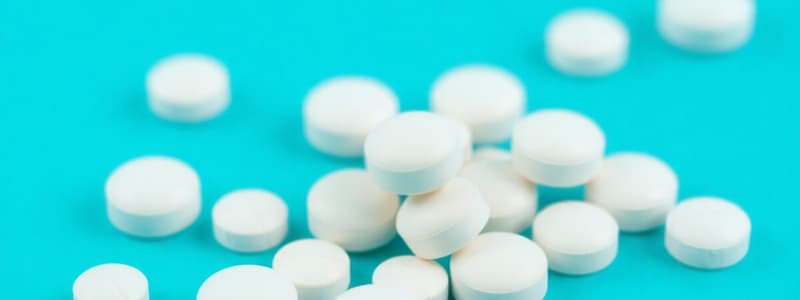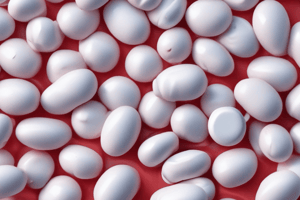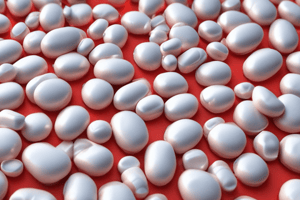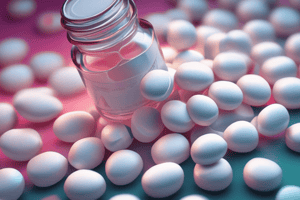Podcast
Questions and Answers
What is the primary mechanism by which aspirin exerts its anti-inflammatory effects?
What is the primary mechanism by which aspirin exerts its anti-inflammatory effects?
- Irreversibly inhibiting cyclooxygenase (COX) enzymes through acetylation. (correct)
- Directly blocking prostaglandin receptors.
- Stimulating the production of anti-clotting prostaglandins.
- Reversibly inhibiting cyclooxygenase (COX) enzymes.
How does aspirin differ from most other NSAIDs in its mechanism of action on cyclooxygenase enzymes?
How does aspirin differ from most other NSAIDs in its mechanism of action on cyclooxygenase enzymes?
- Aspirin directly stimulates COX enzyme production, while others inhibit it.
- Aspirin inhibits cyclooxygenase enzymes by competing with the enzyme’s substrates for access to the active site, while other NSAIDs act by acetylation
- Aspirin only affects COX-1, while others affect COX-2.
- Aspirin inhibits cyclooxygenase enzymes by acetylation, while most others compete with the enzyme’s substrates for access to the active site. (correct)
What chemical modification does aspirin undergo when it interacts with a serine residue in the active site of a COX enzyme?
What chemical modification does aspirin undergo when it interacts with a serine residue in the active site of a COX enzyme?
- Deamination
- Methylation
- Acetylation (correct)
- Hydroxylation
Why does aspirin's effect on blood clotting last longer in platelets compared to cells lining the blood vessels?
Why does aspirin's effect on blood clotting last longer in platelets compared to cells lining the blood vessels?
How does the acetylation of COX-2 by aspirin contribute to the production of Aspirin-Triggered Lipoxins (ATLs)?
How does the acetylation of COX-2 by aspirin contribute to the production of Aspirin-Triggered Lipoxins (ATLs)?
What is the significance of the portal vein in the context of aspirin's mechanism and its effect on blood clotting?
What is the significance of the portal vein in the context of aspirin's mechanism and its effect on blood clotting?
In the context of aspirin's mechanism of action, what does the term 'homologous' refer to when describing serine 529 in COX-1 and serine 516 in COX-2?
In the context of aspirin's mechanism of action, what does the term 'homologous' refer to when describing serine 529 in COX-1 and serine 516 in COX-2?
Why is acetaminophen preferred over aspirin for treating fever in children and young adults?
Why is acetaminophen preferred over aspirin for treating fever in children and young adults?
What is the role of TxA2, which is generated by cyclooxygenase enzymes in blood platelets?
What is the role of TxA2, which is generated by cyclooxygenase enzymes in blood platelets?
How does aspirin contribute to blood thinning?
How does aspirin contribute to blood thinning?
What is the chemical difference between a lipoxin and an Aspirin-Triggered Lipoxin (ATL)?
What is the chemical difference between a lipoxin and an Aspirin-Triggered Lipoxin (ATL)?
What is the acetyl group's effect on the hydroxyl group's nucleophilicity in the serine residue of COX enzymes during aspirin's mechanism of action?
What is the acetyl group's effect on the hydroxyl group's nucleophilicity in the serine residue of COX enzymes during aspirin's mechanism of action?
What is a key characteristic that differentiates the effect of aspirin from that of salicylic acid, its precursor?
What is a key characteristic that differentiates the effect of aspirin from that of salicylic acid, its precursor?
How does irreversible inhibition of COX enzymes by aspirin affect the body's response?
How does irreversible inhibition of COX enzymes by aspirin affect the body's response?
Why was aspirin originally synthesized by Felix Hoffman?
Why was aspirin originally synthesized by Felix Hoffman?
Which statement best describes the role of PGI2 (prostacyclin) in blood clotting?
Which statement best describes the role of PGI2 (prostacyclin) in blood clotting?
What is the primary reason for aspirin being prescribed at low doses for patients with a history of stroke or heart disease?
What is the primary reason for aspirin being prescribed at low doses for patients with a history of stroke or heart disease?
What is the potential risk of aspirin use for individuals with asthma?
What is the potential risk of aspirin use for individuals with asthma?
What is the initial source of salicin, a precursor to salicylic acid, which led to the development of aspirin?
What is the initial source of salicin, a precursor to salicylic acid, which led to the development of aspirin?
How does aspirin's acetylation of COX enzymes affect the enzyme's active site?
How does aspirin's acetylation of COX enzymes affect the enzyme's active site?
Flashcards
Aspirin
Aspirin
A NSAID belonging to the salicylic acid structural class with antipyretic, analgesic, and anti-inflammatory effects.
Salicin
Salicin
A precursor to salicylic acid, found in willow leaves and meadowsweet, historically used for fever.
Acetylsalicylic Acid
Acetylsalicylic Acid
Synthesized by Felix Hoffman at Bayer by adding an acetyl group to salicylic acid.
Cyclooxygenase (COX) Enzymes
Cyclooxygenase (COX) Enzymes
Signup and view all the flashcards
Acetylation by Aspirin
Acetylation by Aspirin
Signup and view all the flashcards
Irreversible Inhibition of COX
Irreversible Inhibition of COX
Signup and view all the flashcards
Prostaglandins Role
Prostaglandins Role
Signup and view all the flashcards
TxA2
TxA2
Signup and view all the flashcards
PGI2
PGI2
Signup and view all the flashcards
Platelet COX Inhibition
Platelet COX Inhibition
Signup and view all the flashcards
Salicylic Acid
Salicylic Acid
Signup and view all the flashcards
Aspirin-Triggered Lipoxins (ATLs)
Aspirin-Triggered Lipoxins (ATLs)
Signup and view all the flashcards
15-epi-lipoxin-A4
15-epi-lipoxin-A4
Signup and view all the flashcards
Reye’s Syndrome
Reye’s Syndrome
Signup and view all the flashcards
Acetaminophen (Tylenol)
Acetaminophen (Tylenol)
Signup and view all the flashcards
Study Notes
- Aspirin is a NSAID that belongs to the salicylic acid structural class
- Commonly prescribed for antipyretic, analgesic, and anti-inflammatory effects
History
- Ancient Greeks used willow leaves and meadowsweet for fever
- Salicin, a precursor to salicylic acid, was found in these plants
- Salicylic acid was used to treat arthritis in the early 1800s
- Had poor patient tolerance due to taste and gastric side effects
- In 1899, Felix Hoffman at Bayer Pharmaceuticals synthesized aspirin from salicylic acid.
Acetylsalicylic Acid
- Hoffman added an acetyl group to salicylic acid, which created acetylsalicylic acid, or aspirin
- Modification caused it to irreversibly inhibit cyclooxygenase (COX) enzymes by acetylation
- Most other NSAIDs inhibit cyclooxygenase enzymes by competing with the enzyme’s substrates for access to the active site
Acetylation
- Aspirin transfers its acetyl group to an amino acid residue in the active site of COX enzymes
- Acetylates serine 529 in COX-1
- Acetylates serine 516 in COX-2
- Serine residues are homologous, having the same relative position and function in the active site
- Difference in number is due to slight variations in the amino acid sequence of the two enzymes
- An oxygen atom attacks the carbonyl on aspirin and is acetylated, converting aspirin into salicylic acid
- Acetylation nullifies the nucleophilicity of the hydroxyl group in the serine residue
- Alters the structure of the active site, rendering the enzyme permanently ineffective
Irreversible Inhibition
- Irreversible inhibition of COX enzymes causes body to create new enzymes before the effect of aspirin wears off
Blood Clotting
- Effective in preventing blood clotting at very low doses
- Prostaglandins are produced in blood platelets and epithelial cells lining of blood vessels
- Important for blood clotting activity
- Cyclooxygenase enzymes in blood platelets generate TxA2 (pro-clotting prostaglandin)
- Cells in blood vessels generate PGI2 (anti-clotting prostaglandin)
- Platelets lack a nucleus so cannot generate new RNA transcripts for protein production
- Inhibited COX enzymes prevent platelets from generating pro-clotting prostaglandins for their 8-9 day lifespan
- Cells lining blood vessels continually generate new COX enzymes, thus can still generate anti-clotting prostaglandins
- Shift causes blood thinning effects
- COX enzymes in platelets are acetylated within the portal vein
- Carries blood from the gut (aspirin absorption location) to the liver (where aspirin is metabolized into salicylic acid)
Aspirin-Triggered Lipoxins (ATLs)
- Acetylation of cyclooxygenase-2 by aspirin leaves certain enzyme functions intact
- ATLs such as 15-epi-lipoxin-A4 are created
- Epimer of a lipoxin, differing in the stereochemistry of one chiral center
- Has potent anti-inflammatory effects and likely increases aspirin’s anti-inflammatory activity
Uses & Side Effects
- Potent and clinically important NSAID for the treatment of fever and pain
- Low doses treat heart disease or patients who have had a stroke
- 10-25% of people with asthma have worsened symptoms with aspirin use
- Has been associated with Reye’s syndrome
- Primarily occurs in young people
- Characterized by swelling of the liver and brain
- Due to this association, aspirin is not used in children, or young adults with a virus-induced fever.
- Acetaminophen (Tylenol) has not been implicated in Reye’s syndrome and has less significant gastric side effects
- It is the drug of choice for the treatment of fever in children and young adults
Studying That Suits You
Use AI to generate personalized quizzes and flashcards to suit your learning preferences.




